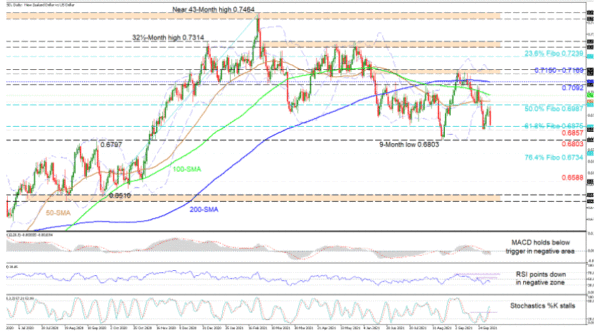NZDUSD appears to have failed to capitalise on the 25bps rate hike to 0.50% out of the Reserve Bank of New Zealand (RBNZ), which was delivered in the Asian trading session. The pair is dropping towards the 0.6875 level, that being the 61.8% Fibonacci retracement of the up leg from 0.6510 until 0.7464, the lower region of a mostly sideways market that began around June 18. The overall trendless simple moving averages (SMAs) are also confirming the fairly ranging price action in the pair.
The short-term oscillators are reflecting the increase in negative impetus. The MACD is falling beneath its red trigger line in the bearish region, while the RSI is indicating the rise in downward forces. The stalling in the stochastic %K line is hinting that sellers may soon gain a clear upper hand, extending the recent price decline.
If sellers maintain control, a prompt support zone could arise from the 61.8% Fibo of 0.6875 until the neighbouring low of 0.6857. If the price steers past the lower Bollinger band, next downside friction could transpire from the 9-month trough of 0.6803. Should this bottom defence of the recently ranging market fail to halt further declines from unfolding, the pair may then shoot for the 76.4% Fibo of 0.6734 before diving for the 0.6588 barrier.
In the event buyers return and push the price higher, upside constraints could commence from the 50.0% Fibo of 0.6987 and the resistance region overhead between the 50-day SMA at 0.7003 and the 100-day SMA at 0.7037. Conquering these tough obstacles may reinforce positive powers to challenge the 0.7092-0.7106 barricade. Should buying interest prevail above the 200-day SMA, the 0.7150-0.7169 ceiling of the three-and-a-half-month consolidation could calm buoyant buyers from reaching the 23.6% Fibo of 0.7239.
Summarizing, in the short-term picture, NZDUSD is exhibiting a slight negative demeanour despite being stuck in a trading range. For a more definitive direction to mature, the price would need to break either below 0.6803 or above 0.7169.













